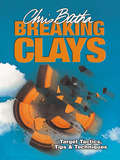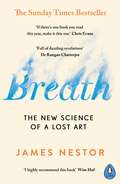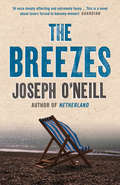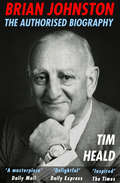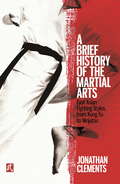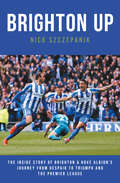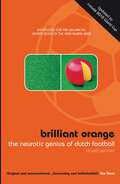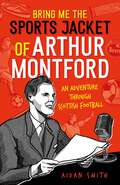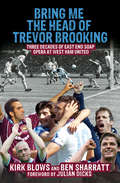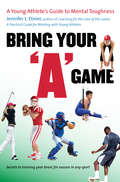- Table View
- List View
Breaking 80
by David GodwinForget the Ryder Cup, forget Rory McIlroy, forget keeping your head still and correcting your putting stance. Forget eagles and albatrosses and definitely forget holes-in-one. David Godwin has a dream, the same dream held by millions of amateur golfers. He's not aiming to break on to the pro circuit, he's not aiming to break par. David Godwin is going to break 80. Or it's going to break him.Written with humour and charm, Breaking 80 is a book for those who recognise all too well the pleasure of a sweetly struck seven iron to within a few feet of the pin, followed by the agonizing fury of a three-putt back and forth across the cup.
Breaking The Chain: Drugs and Cycling - The True Story
by Willy Voet-------------------------------On 8 July 1998 Festina team soigneur Willy Voet was stopped by the police. In his car were the drugs the team needed if they were to have any chance of playing a competitive part in the 1998 Tour de France. The car was searched, he was immediately arrested and so the story that has been undermining the sport of cycling since the death of Tommy Simpson in 1967, finally broke. Imprisoned for sixteen days, sacked from the Festina team and ostracised from the sport to which he had dedicated his life, Willy Voet at last was able to tell the truth. His sensational story will change cycling forever.Cocaine, amphetamines, EPO, heroin - all these are now considered not optional but necessary, not to win but just to compete in the Tour de France. Details of how these drugs are obtained, mixed together to make cocktails, administered and concealed are all included in this graphic and uninhibited account of how drugs brought cycling to its knees.
Breaking Clays: Target, Tactics, Tips and Techniques
by Chris BathaBreaking Clays is a comprehensive manual and practical book that presents in-depth advice and instruction for shooters for all disciplines. From the basics to proven tournament techniques, this book is packed with invaluable tips on how to break more clay in your chosen game.
Breaking the Mould
by Angela PipposAn extraordinary transformation is taking place in Australian sport; from suburban footy fields to stadium cage fights, sportswomen are breaking through the 'grass ceiling' and competing for a fair go. Where recently horses received more media coverage than female athletes, women are now commanding attention with undeniable performances and fierce determination. Through personal tales from a lifetime in sport, as well as interviews with pioneering athletes and administrators, journalist Angela Pippos provides a fascinating insight into the seismic shift occurring in the games we play. Breaking the Mould is a timely, entertaining and compelling reminder of why we must level the playing field permanently, so that every woman has the opportunity to become her sporting best.
Breaking Vegas
by Ben MezrichFor nearly five years, he was known as the 'Darling Of Las Vegas'; the biggest high roller to hit Sin City in decades, a hotshot, twenty one year-old kid with a seemingly unlimited bankroll and an even more unlimited lust for big money action. His name was Semyon Dukatch, and stories swirled in his wake. Some said he was a Russian arms dealer, others a pop star from Eastern Europe. But the truth was even more unlikely: he was a twenty-one year old graduate student who had a plan that would one day make him richer than anyone could possibly imagine. The Darling of Las Vegas quickly became a legend in the casino world. He is the only person banned from the island of Aruba. He was held, at gunpoint, in a cave in Monte Carlo and told that if he ever returned, he'd be murdered. And he made millions of dollars playing blackjack, using three simple techniques that gave him the edge, techniques that are revealed in this book for the first time.This is his story, the ultimate true story of Las Vegas, the book Vegas doesn't want you to read...
Breath: The New Science of a Lost Art
by James Nestor'Who would have thought something as simple as changing the way we breathe could be so revolutionary for our health, from snoring to allergies to immunity? A fascinating book, full of dazzling revelations' Dr Rangan ChatterjeeNo matter what you eat, how much you exercise, how skinny or young or wise you are, none of it matters if you're not breathing properly.There is nothing more essential to our health and wellbeing than breathing: take air in, let it out, repeat 25,000 times a day. Yet, as a species, humans have lost the ability to breathe correctly, with grave consequences. Journalist James Nestor travels the world to figure out what went wrong and how to fix it.The answers aren't found in pulmonology labs, as we might expect, but in the muddy digs of ancient burial sites, secret Soviet facilities, New Jersey choir schools, and the smoggy streets of São Paulo, Brazil. Nestor tracks down men and women exploring the hidden science behind ancient breathing practices like Pranayama, Sudarshan Kriya and Tummo and teams up with pulmonary tinkerers to scientifically test longheld beliefs about how we breathe.Modern research is showing us that making even slight adjustments to the way we inhale and exhale can jump-start athletic performance, rejuvenate internal organs, halt snoring, allergies, asthma and autoimmune disease, and even straighten scoliotic spines. None of this should be possible, and yet it is.Drawing on thousands of years of medical texts and recent cutting-edge studies in pulmonology, psychology, biochemistry and human physiology, Breath turns the conventional wisdom of what we thought we knew about our most basic biological function on its head. You will never breathe the same again.
Breath: A Coming of Age Story and a Love Letter to Surfing and the Sea
by Tim Winton‘Exhilarating’ – Sunday Times‘Rapturous’ – Sunday Telegraph‘A remarkable tale of grace and danger’ – Financial TimesWhen paramedic Bruce Pike is called out to deal with another teenage adventure gone wrong, he knows better than anyone what happened and how. Thirty years before, that dead boy could have been him. Bruce remembers what it was like to be a risk-taking kid, to feel that thrill and that fear . . .Breath by Tim Winton is the story of Bruce and his best friend Loonie, and the surfing obsession that changed both of their lives. It is about the exhilaration of the sea and the waves, the treacherous addiction to risk, and the intoxicating power of forbidden love.Now a film by Simon Baker.
Breathe: A Life In Flow
by Rickson GracieFrom legendary Brazilian Jiu-Jitsu and MMA master Rickson Gracie comes a riveting, insightful memoir that weaves together the story of Gracie’s stunning career with the larger history of the Gracie family dynasty, showing how the connection between mind and body can be harnessed for success both inside and outside the ring.
Breathing on the Roof of the World: Memoir of a Respiratory Physiologist (Springer Biographies)
by John B. WestThis book is an informal autobiography by John West MD PhD. He obtained his medical degree in Adelaide, Australia and then spent 15 years mainly at the Royal Postgraduate Medical School, Hammersmith Hospital in London where he, with others, used radioactive oxygen-15 to make the first description of the uneven regional distribution of blood flow in the lung. In 1960-1961, he was a member of the Himalayan Scientific and Mountaineering Expedition led by Sir Edmund Hillary who had made the first ascent of Mt Everest 7 years before. During the expedition about 6 scientists spent up to three months at an altitude of 5800 m studying the effects of this very high altitude on human physiology. Because of his interests in the effects of gravity on the lung, Dr. West spent a year at the NASA Ames Research Center in Mountain View, California in 1967-1968. While there he submitted a proposal to NASA to measure pulmonary function of astronauts in space, and this was funded. Later, in 1981 he organized the American Medical Research Expedition to Everest during which the first measurements of human physiology on the summit, altitude 8848 m, were obtained. In the 1990’s, Dr. West’s team made the first comprehensive measurements of pulmonary function of astronauts in space using SpaceLab which was taken up in the Shuttle.
The Breezes
by Joseph O’NeillA brilliant and darkly comic novel from the Man Booker Prize longlisted author of ‘Netherland’.
Brian Clough: The Biography
by Jonathan WilsonThe final word on Brian CloughIn this first full, critical biography, Jonathan Wilson draws an intimate and powerful portrait of one of England's greatest football managers, Brian Clough, and his right-hand man, Peter Taylor. It was in the unforgiving world of post-war football where their identities and reputations were made - a world where, as Clough and Taylor's mentor Harry Storer once said, 'Nobody ever says thank you.'Nonetheless, Clough brought the gleam of silverware to the depressed East Midlands of the 1970s. Initial triumph at Derby was followed by a sudden departure and a traumatic 44 days at Leeds. By the end of a frazzled 1974, Clough was set up for life financially, but also hardened to the realities of football. By the time he was at Forest, Clough's mask was almost permanently donned: a persona based on brashness and conflict. Drink fuelled the controversies and the colourful character; it heightened the razor-sharp wit and was a salve for the highs of football that never lasted long enough, and for the lows that inevitably followed. Wilson's account is the definitive portrait of this complex and enduring man.
Brian Johnston: The Authorized Biography
by Tim HealdDescriptionHow did it work, exactly, that Johnners magic? Brian Johnston was arguably the most distinctive and best loved voice in British broadcasting. Elder statesman of the Test Match Special team, he was also Britain's most entertaining commentator with an irrepressible and infectious sense of humour. Johnners also had an enviable talent like few other broadcasters of making his listeners feel like close, personal friends.Drawing on Brian Johnston's own papers and other previously unpublished sources as well as conversations with an enormous selection of his friends and colleagues, Tim Heald's fully authorised biography brings to us the many different sides of Johnners and encapsulates brilliantly his truly remarkable life.Praise for Brian Johnston'Tim Heald is a good writer, an assiduous researcher and an experienced biographer... The result is outstanding, so revealing that you have to refer to the dust jacket to reassure yourself this is authorised... There has never been an Englishman quite like Brian Johnston. Tim Heald, without rocking boats or destroying legends, has written a masterpiece which will humanise the legend' Daily Mail'Heald's light touch and anecdotal approach are entirely in keeping with the man -Johnners would have approved' Time Out'Packed as sweetly as some rich cake with... fun and humour... Inspired' The Times'Delightful' Daily Express
Brian Little - A Little Is Enough
by Simon GoodyearOn leaving school in 1969, Brian signed as an apprentice for Aston Villa who had just been relegated to the Third Division for the first and only time in their history. He made his senior debut on 30 October 1971, in a 4 – 1 win over Blackburn Rovers at Villa Park. In that same season, he also helped Villa win the FA Youth Cup. He was part of Villa's League Cup winning teams of 1975 and 1977 and scored two goals in the second replay victory over Everton in the 1977 final. Brian helped the club climb from the Third to First Division in the early part of the decade, scoring 20 league goals in the 1974 – 1975 season when they were runners-up and clinched promotion to the First Division. His starring roles earned him his first (and only) cap for the full England team in a substitute appearance against Wales at Wembley in May 1975.By the 1979 – 1980 season, Brian was a regular in the Villa side, but one year later, just before Villa’s victorious 1980 – 1981 season, his career ended prematurely because of a knee injury, after making 302 appearances for his one and only club, scoring 82 goals in all competitions and having a clean disciplinary record to boot.Although his playing career was over, Brian remained on the Aston Villa payroll as youth team coach. When manager Tony Barton was sacked in the summer of 1984, Little's contract was also terminated and he became first-team coach of Wolverhampton Wanderers, before embarking on a hugely successful managerial career.Brian Little will be known as a flamboyant forward who formed a particularly prolific partnership with John Deehan and Andy Gray. He is regarded as an all-time great at Villa Park, and in 2007 he was named as one of the 12 founder members of the Aston Villa Hall of Fame.
Bridge yoga posture (large print)
by Rnib BookshareThis image can only give an insight into what yoga is. It cannot be used alone as a training / user guide. The posture is only one from hundreds of possibilities and cannot be used in isolation. Yoga must be taught with breathing exercises and sequencing of postures. Each posture involves a timed procedure of movement, breathing and focused thought, not a static exercise position. There are three images of a side view of a woman on the floor with her head to the left, feet to the right, separated by two dashed lines on the page. In each image she wears a vest and leggings. There is a locator dot shown which will be in the top left of the page when the image is the correct way up. The image at the top of the page is the developing full bridge posture. On the left of the page the middle of her head is obscured by her lower arm which goes vertically down from the elbow to the hand. At the wrist the hand is at ninety degrees pointing to the right. From the elbow in the top left of the image the upper arm goes right and down to the shoulder. The body, facing upwards then goes up and right in a straight line to the knees. In the top right of the image the lower leg bends sharply at the knee and goes vertically down to a foot in the bottom right of the image. The image in the middle of the page is the full bridge posture. The hand in the bottom left is flat to the floor pointing to the right. The wrist is bent very sharply and the arm is straight, going up and right. The upper arm obscures most of her face. Her body, facing upwards curves round in an arc to her knees. From the knee the lower leg goes vertically down to the foot which points to the right in the bottom right of the image. The image in the bottom of the page is the easy or beginner's bridge posture. The woman's head lies on the floor looking up. Her shoulders and arm are flat on the floor. From her shoulders her body arches slightly going up and right. Her leg bends at ninety degrees at the knee and the lower leg goes vertically down to the foot which points to the right in the bottom right of the image.
Bridge yoga posture (UEB Contracted)
by Rnib BookshareThis image can only give an insight into what yoga is. It cannot be used alone as a training / user guide. The posture is only one from hundreds of possibilities and cannot be used in isolation. Yoga must be taught with breathing exercises and sequencing of postures. Each posture involves a timed procedure of movement, breathing and focused thought, not a static exercise position. There are three images of a side view of a woman on the floor with her head to the left, feet to the right, separated by two dashed lines on the page. In each image she wears a vest and leggings. There is a locator dot shown which will be in the top left of the page when the image is the correct way up. The image at the top of the page is the developing full bridge posture. On the left of the page the middle of her head is obscured by her lower arm which goes vertically down from the elbow to the hand. At the wrist the hand is at ninety degrees pointing to the right. From the elbow in the top left of the image the upper arm goes right and down to the shoulder. The body, facing upwards then goes up and right in a straight line to the knees. In the top right of the image the lower leg bends sharply at the knee and goes vertically down to a foot in the bottom right of the image. The image in the middle of the page is the full bridge posture. The hand in the bottom left is flat to the floor pointing to the right. The wrist is bent very sharply and the arm is straight, going up and right. The upper arm obscures most of her face. Her body, facing upwards curves round in an arc to her knees. From the knee the lower leg goes vertically down to the foot which points to the right in the bottom right of the image. The image in the bottom of the page is the easy or beginner's bridge posture. The woman's head lies on the floor looking up. Her shoulders and arm are flat on the floor. From her shoulders her body arches slightly going up and right. Her leg bends at ninety degrees at the knee and the lower leg goes vertically down to the foot which points to the right in the bottom right of the image.
Bridge yoga posture (UEB Uncontracted)
by Rnib BookshareThis image can only give an insight into what yoga is. It cannot be used alone as a training / user guide. The posture is only one from hundreds of possibilities and cannot be used in isolation. Yoga must be taught with breathing exercises and sequencing of postures. Each posture involves a timed procedure of movement, breathing and focused thought, not a static exercise position. There are three images of a side view of a woman on the floor with her head to the left, feet to the right, separated by two dashed lines on the page. In each image she wears a vest and leggings. There is a locator dot shown which will be in the top left of the page when the image is the correct way up. The image at the top of the page is the developing full bridge posture. On the left of the page the middle of her head is obscured by her lower arm which goes vertically down from the elbow to the hand. At the wrist the hand is at ninety degrees pointing to the right. From the elbow in the top left of the image the upper arm goes right and down to the shoulder. The body, facing upwards then goes up and right in a straight line to the knees. In the top right of the image the lower leg bends sharply at the knee and goes vertically down to a foot in the bottom right of the image. The image in the middle of the page is the full bridge posture. The hand in the bottom left is flat to the floor pointing to the right. The wrist is bent very sharply and the arm is straight, going up and right. The upper arm obscures most of her face. Her body, facing upwards curves round in an arc to her knees. From the knee the lower leg goes vertically down to the foot which points to the right in the bottom right of the image. The image in the bottom of the page is the easy or beginner's bridge posture. The woman's head lies on the floor looking up. Her shoulders and arm are flat on the floor. From her shoulders her body arches slightly going up and right. Her leg bends at ninety degrees at the knee and the lower leg goes vertically down to the foot which points to the right in the bottom right of the image.
The Bridleway: How Horses Shaped the British Landscape
by Tiffany Francis-BakerTiffany Francis-Baker explores how the relationship between humans and horses has shaped the British landscape, how horses have captured our wild imaginations, and how this connection has evolved and become part of our nation's ecosystems. Many of us enjoy walking on a bridleway. These ancient networks are familiar to walkers and riders and crisscross the British countryside, but we rarely stop to think about how these old routes came to be. In The Bridleway, Tiffany Francis-Baker examines our relationship with horses and ponders how they have become part of our nation's ecosystems. From atop her horse, Tiffany discovers how horses are woven into the fabric of British culture, from street and pub names to trading routes and coaching inns. As she investigates how horses have shaped British landscapes, she offers a glimpse into the intriguing history of the bridleway. Along the way, Tiffany visits a horse fair and learns about Traveller communities. She explores the role of equestrian sport and inclusivity, sees rewilding in action on the Knepp Estate in Sussex and undertakes detective work to uncover ancient bridleways lost to time and meet the closest living ancestors of the truly wild horse. Part-domesticated and part-fiercely independent, horses can teach us a lot about our landscape and help us understand nature and our place within it. Except for the dogs and cats we choose to share our homes with, we have allowed horses far deeper into our society than any other animal. And as Tiffany investigates why horses have captured Britons' attention, she reveals how deeply rooted they have been in our culture for thousands of years.
The Bridleway: How Horses Shaped the British Landscape
by Tiffany Francis-BakerTiffany Francis-Baker explores how the relationship between humans and horses has shaped the British landscape, how horses have captured our wild imaginations, and how this connection has evolved and become part of our nation's ecosystems. Many of us enjoy walking on a bridleway. These ancient networks are familiar to walkers and riders and crisscross the British countryside, but we rarely stop to think about how these old routes came to be. In The Bridleway, Tiffany Francis-Baker examines our relationship with horses and ponders how they have become part of our nation's ecosystems. From atop her horse, Tiffany discovers how horses are woven into the fabric of British culture, from street and pub names to trading routes and coaching inns. As she investigates how horses have shaped British landscapes, she offers a glimpse into the intriguing history of the bridleway. Along the way, Tiffany visits a horse fair and learns about Traveller communities. She explores the role of equestrian sport and inclusivity, sees rewilding in action on the Knepp Estate in Sussex and undertakes detective work to uncover ancient bridleways lost to time and meet the closest living ancestors of the truly wild horse. Part-domesticated and part-fiercely independent, horses can teach us a lot about our landscape and help us understand nature and our place within it. Except for the dogs and cats we choose to share our homes with, we have allowed horses far deeper into our society than any other animal. And as Tiffany investigates why horses have captured Britons' attention, she reveals how deeply rooted they have been in our culture for thousands of years.
A Brief History of the Martial Arts: East Asian Fighting Styles, from Kung Fu to Ninjutsu (Brief Histories)
by Jonathan ClementsFolk tales of the Shaolin Temple depict warrior monks with superhuman abilities. Today, dozens of East Asian fighting styles trace their roots back to the Buddhist brawlers of Shaolin, although any quest for the true story soon wanders into a labyrinth of forgeries, secret texts and modern retellings.This new study approaches the martial arts from their origins in military exercises and callisthenics. It examines a rich folklore from old wuxia tales of crime-fighting heroes to modern kung fu movies. Centre stage is given to the stories that martial artists tell themselves about themselves, with accounts (both factual and fictional) of famous practitioners including China's Yim Wing-chun, Wong Fei-hong, and Ip Man, as well as Japanese counterparts such as Kano Jigoro, Itosu Anko and So Doshin.The history of martial arts encompasses secret societies and religious rebels, with intimate glimpses of the histories of China, Korea and Japan, their conflicts and transformations. The book also charts the migration of martial arts to the United States and beyond. Special attention is paid to the turmoil of the twentieth century, the cross-cultural influence of Japanese colonies in Asia, and the post-war rise of martial arts in sport and entertainment - including the legacy of Bruce Lee, the dilemma of the ninja and the global audience for martial arts in fiction.
Brighton Up
by Nick SzczepanikBrighton Up: The Inside Story of Brighton & Hove Albion's Journey From Despair to Triumph and the Premier League tells the story of how Brighton & Hove Albion Football Club bounced back from the heartbreak of missing out on promotion to the Premier League by the narrowest of margins, to achieve that ultimate goal earlier this month. Acclaimed sports journalist Nick Szczepanik, a lifelong Brighton fan with strong contacts at the club, documents its travails over two turbulent seasons.The book explains how the Seagulls, written off as certainties for relegation to League One before the 2015-16 season, overcame the loss of one of their own in the Shoreham Air Show tragedy to go on a record unbeaten run. But although top scorers in the Championship, they fell agonisingly short of their target of automatic promotion by a single goal, then lost out again in the lottery of the play-offs.The football world expected them to be crushed by disappointment and outspent by the big guns of Newcastle, Norwich and Aston Villa, but instead they regrouped and came back stronger in 2016-17.Led by experienced and inscrutable manager Chris Hughton and backed by owner Tony Bloom - the world-class poker player nicknamed 'The Lizard' for his ice-cold blood - they played with a determination not to let the heartbreak happen again.
Brilliant Orange: The Neurotic Genius of Dutch Football
by David WinnerThe Netherlands has been one of the world's most distinctive and sophisticated football cultures. From the birth of Total Football in the sixties, through two decades of World Cup near misses to the exiles who remade clubs like AC Milan, Barcelona, Arsenal and Chelsea in their own image, the Dutch have often been dazzlingly original and influential. The elements of their style (exquisite skills, adventurous attacking tactics, a unique blend of individual creativity and teamwork, weird patterns of self-destruction) reflect and embody the country's culture and history. This book lays bare the elegant, fractured soul of the Dutch Masters and the culture that spawned them by exploring and analysing its key ideas, institutions, personalities and history in the context of wider Dutch society.
Bring Me Sports Jacket of Arthur Montford: An Adventure Through Scottish Football
by Aidan SmithTake a hilarious romp through the best and worst of Scottish footballing history. The Scot who won England the World Cup. Macaroon bars and Bovril. When Dixie Deans met Bob Marley. When Davie Robb met Olivia Newton-John. When George McCluskey met the Stones. When Rick Wakeman filed match reports for Meadowbank Thistle. Triumphs and disasters, submarines and rowing boats, War and Peace (who’s read it). The Cowdenbeath kettle. The Brechin hedge. Morton’s great Danes. Icarus at East Fife. The dead pigeon sketch and the amazing technicolor booze-coat. The can girls. Those who flogged ice cream and licked Hitler. The world’s oldest conjoined twins. Inside the half-time scoreboards. Our greatest goal, our greatest assist, our keepers. Scarlett Johansson! And of course Arthur Montford - commentator, curator, favourite uncle to the nation. In Bring Me the Sports Jacket of Arthur Montford, Aidan Smith mines Scottish football history for quirk, strangeness and charm. On a journey that takes him to Albania and also Albion Rovers, great players are celebrated and so are great characters. Rediscover old legends (not told this way before) and maybe learn about new ones. If there’s a running theme it’s that our game, its participants and those who watch in the rain are one and the same thing - indomitable.
Bring Me the Head of Sergio Garcia
by Tom CoxAs a teenager, Cox dreamed of sporting immortality. For four years he devoted himself to the game of golf. And then, one day, he walked away. But as he got older, those dreams kept coming back. Perhaps it was turning thirty, perhaps it was having his first hole in one, but he decided it was time to start again, to live the dream for real.So he switched off his computer, grabbed his checked trouser and headed for the golf course. To turn pro. The Open Championship was only five of the best rounds of his life away, and given a few warm-up tournaments, how hard could it be?
Bring Me the Head of Trevor Brooking: Three Decades of East End Soap Opera at West Ham United
by Ben Sharratt Kirk BlowsWest Ham United last won a major trophy in 1980, but the roller-coaster ride of the past three decades has produced enough twists and turns, heroes and villains and contrasting emotions to grace the script of the most thrilling TV soap opera.Since Trevor Brooking headed home the FA Cup final winner against Arsenal, the Hammers have experienced delight and despair in not so equal measure, with a cast of controversial characters - either adored or abhorred - playing the key roles in a tale of fact rather than fiction.The saving of the club by David Sullivan and David Gold, as West Ham stared into the financial abyss following the ill-fated Bjorgolfur Gudmundsson reign, is the latest chapter in a saga that includes numerous promotions and relegations, great escapes, contentious changes of ownership and management, internal feuds, bust-ups and power struggles, the Carlos Tevez affair and the passing of legends Ron Greenwood, John Lyall and Bobby Moore, as well as several false dawns in the endless quest for success.Including exclusive interviews with key protoganists, Bring Me the Head of Trevor Brooking tells - for the very first time - the inside story behind 60 of the most significant developments at Upton Park in the modern era. Whether examining the contributions of Paolo Di Canio, Harry Redknapp and Frank McAvennie or Gianfranco Zola, Marco Boogers and Iain Dowie, the book celebrates the good, the bad and the ugly of West Ham United.
Bring Your "A" Game: A Young Athlete's Guide to Mental Toughness
by Jennifer L. EtnierMental training is just as important as physical training when it comes to success in sport. And like physical fitness, mental toughness is something that can be taught and learned. Yet many young athletes have not learned the psychological skills needed to develop their best game. This book was written specifically for young athletes interested in improving their performance and reaching their potential in sport. Bring Your "A" Game introduces key strategies for mental training, such as goal setting, pre-performance routines, confidence building, and imagery. Each of the seventeen chapters focuses on a single mental skill and offers key points and exercises designed to reinforce the concepts. The book encourages athletes to incorporate these mental skills into their daily lives and practice sessions so that they become second nature during competition.Whether used at home by student athletes or assigned by coaches as part of team development, Bring Your "A" Game will help young performers develop a plan for success and learn to deal with the challenges of pursuing excellence in sport.


